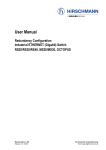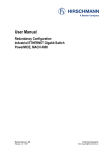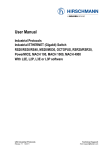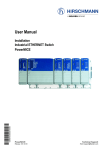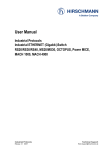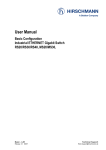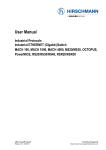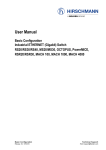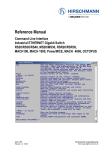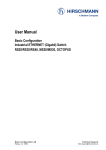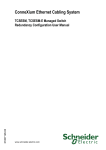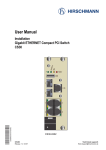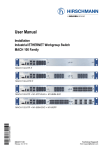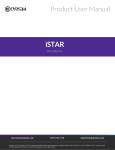Download User Manual Redundancy Configuration L2E
Transcript
User Manual Redundancy Configuration Industrial ETHERNET (Gigabit) Switch RS20/RS30/RS40, MS20/MS30, OCTOPUS Redundancy L2E Release 4.1 03/08 Technical Support [email protected] The naming of copyrighted trademarks in this manual, even when not specially indicated, should not be taken to mean that these names may be considered as free in the sense of the trademark and tradename protection law and hence that they may be freely used by anyone. © 2008 Hirschmann Automation and Control GmbH Manuals and software are protected by copyright. All rights reserved. The copying, reproduction, translation, conversion into any electronic medium or machine scannable form is not permitted, either in whole or in part. An exception is the preparation of a backup copy of the software for your own use. For devices with embedded software, the end-user license agreement on the enclosed CD applies. The performance features described here are binding only if they have been expressly guaranteed in the contract. This publication has been created by Hirschmann Automation and Control GmbH according to the best of our knowledge. Hirschmann reserves the right to change the contents of this manual without prior notice. Hirschmann can give no guarantee in respect of the correctness or accuracy of the details in this publication. Hirschmann can accept no responsibility for damages, resulting from the use of the network components or the associated operating software. In addition, we refer to the conditions of use specified in the license contract. Printed in Germany Hirschmann Automation and Control GmbH Stuttgarter Str. 45-51 72654 Neckartenzlingen Germany Tel.: +49 1805 141538 Rel. 4.1-01-0308 – 17.4.08 Content Content About this Manual 5 Key 6 1 Introduction 9 1.1 Comparison of the redundancy procedures 10 2 HIPER-Ring 11 2.1 Configuring HIPER-Ring Version 1 13 2.2 Configuring HIPER-Ring Version 2 (MRP Draft) 17 3 Redundant coupling 21 3.1 The variants of redundant coupling 22 3.2 Configuring the redundant coupling 3.2.1 STAND-BY switch 3.2.2 One-Switch coupling 3.2.3 Two-Switch coupling 3.2.4 Two-Switch coupling with control line 24 24 27 33 40 4 Rapid Spanning Tree 49 4.1 The Spanning Tree Protocol 4.1.1 The tasks of the STP 4.1.2 Bridge parameters 4.1.3 Bridge Identifier 4.1.4 Root Path Costs 4.1.5 Port Identifier 50 50 51 51 52 53 4.2 Rules for creating the tree structure 4.2.1 Bridge information 4.2.2 Setting up the tree structure 54 54 54 4.3 Example of specifying the root paths 56 4.4 Example of manipulating the root paths 58 4.5 Example of manipulating the tree structure 60 Redundancy L2E Release 4.1 03/08 3 Content 4.6 The Rapid Spanning Tree Protocol 4.6.1 Port roles 4.6.2 Port states 4.6.3 Spanning Tree Priority Vector 4.6.4 Fast reconfiguration 4.6.5 Configuring the Rapid Spanning Tree 61 61 63 63 64 65 A Reader´s comments 73 B Index 75 C Further support 77 4 Redundancy L2E Release 4.1 03/08 About this Manual About this Manual The “Redundancy Configuration” user manual contains all the information you need to select a suitable redundancy procedure and configure it. The “Basic Configuration” user manual contains all the information you need to start operating the device. It takes you step by step from the first startup operation through to the basic settings for operation in your environment. The “Installation” user manual contains a device description, safety instructions, a description of the display, and all the other information that you need to install the device before you begin with the configuration of the device. The “Industry Protocols” user manual describes how the device is connected by means of a communication protocol commonly used in the industry, such as EtherNet/IP and PROFINET. The "Web-based Interface" reference manual contains detailed information on using the Web interface to operate the individual functions of the device. The "Command Line Interface" reference manual contains detailed information on using the Command Line Interface to operate the individual functions of the device. The Network Management Software HiVision provides you with additional options for smooth configuration and monitoring: X X X X X X Event logbook. Configuration of „System Location“ and „System Name“. Configuration of the network address range and SNMP parameters. Saving the configuration on the device. Simultaneous configuration of multiple devices. Configuration of the port display color red for a connection error. Redundancy L2E Release 4.1 03/08 5 Key Key The designations used in this manual have the following meanings: X List Work step Subheading Link Note: Indicates a cross-reference with a stored link A note emphasizes an important fact or draws your attention to a dependency. Courier ASCII representation in user interface Execution in the Web-based Interface user interface Execution in the Command Line Interface user interface Symbols used: Router with firewall Switch with firewall Router Switch Bridge Hub 6 Redundancy L2E Release 4.1 03/08 Key A random computer Configuration Computer Server PLC Programmable logic controller I/O Robot Redundancy L2E Release 4.1 03/08 7 Key 8 Redundancy L2E Release 4.1 03/08 Introduction 1 Introduction The device contains a range of redundancy functions: X HIPER-Ring X Redundant coupling of HIPER-Rings and network segments X Rapid Spanning Tree Algorithm (RSTP) Three tools are available for operating these functions: X Web-based Management (supplied with the Switch) for convenient agent configuration (see Reference Manual Web-based Interface). X Command Line Interface (supplied with the Switch) for setting elementary functions (see reference manual – Command Line Interface). X HiVision Network Management for convenient cross-agent configuration (see manual – HiVision Hirschmann Network Management). Redundancy L2E Release 4.1 03/08 9 Introduction 1.1 Comparison of the redundancy procedures 1.1 Comparison of the redundancy procedures RSTP HIPER-Ring Version 1, 2 Switching time < 30 s, < 0.5 s typically < 1 s Practically in(STP < 30 s) dependent of depends the number of heavily on the Switches number of Switches Network topol- Random struc- Ring ogy ture HIPER-Ring Version 3 < 10 ms With 5 Switches in the ring. With more than 5 Switches, the switching time increases. Ring Redundant Link aggregacoupling tion typically 0.15 s - Coupling of network segment/rings via a main line and a redundant line Coupling of network segments via multiple active lines with dynamic load distribution Table 1: Features of the redundancy procedures 10 Redundancy L2E Release 4.1 03/08 HIPER-Ring 2 HIPER-Ring The concept of the HIPER-Ring enables the construction of high-availability, ring-shaped network structures. Using the RM function (Redundancy Manager) of a Switch with the L2E, L2P, L3E or L3P software, you can close both ends of a backbone in a line structure to a redundant ring, the HIPER-Ring (see fig. 1). Within a HIPER-Ring Version 1, any combination of RS1, RS2-../.., RS2-16M, RS2-4R, RS20, RS30, RS40, MICE, PowerMICE, MS 20, MS 30, RSR20, RSR30, MACH 1000, MACH 3000 and MACH 4000 is possible. Within a HIPER-Ring Version 2 (MRP Draft), any combination of devices that support this function is possible. Within a HIPER-Ring Version 3, any combination of RSR20, RSR30 and MACH 1000 is possible. If a section is down, the ring structure of a X HIPER-Ring Version 1 of up to 50 devices typically transforms back to a line structure within 150 ms (adjustable to max. 300 ms/500 ms). X HIPER-Ring Version 2 of up to 50 devices typically transforms back to a line structure within 150 ms (adjustable to max. 200 ms/500 ms). X HIPER-Ring Version 3 of up to 5 devices typically transforms back to a line structure within 5 ms (maximum 10 ms). If a larger number of devices is being used, the reconfiguration time increases. Redundancy L2E Release 4.1 03/08 11 HIPER-Ring Line Redundancy Manager On Redundant Ring Main line Redundant line Figure 1: Line and redundant ring 12 Redundancy L2E Release 4.1 03/08 HIPER-Ring 2.1 Configuring HIPER-Ring Version 1 2.1 Configuring HIPER-Ring Version 1 Set up the network to meet your requirements. Note: Before you connect the redundant line, you must complete the configuration of HIPER-Ring Version 1. You thus avoid loops during the configuration phase. Note: Configure each HIPER-Ring device. Select the Redundancy:HIPER-Ring dialog. Select Version 1. Note: As an alternative to using software to configure HIPER-Ring Version 1, with devices RS20/30/40 and MS20/30 you can also use a DIP switch to enter a number of settings for HIPER-Ring Version 1. You can also use this DIP switch to enter a setting for whether the configuration via DIP switch or the configuration via software has priority. The state on delivery is “Software Configuration”. For each device, you enter the desired ring ports 1 and 2. The following settings are required for the ring ports (select the Basic Settings:Port Configuration dialog): Bit rate Autonegotiation (automatic configuration) Port Duplex 100 Mbit/s Off 1000 Mbit/s On On Full On – Table 2: Port settings for ring ports Redundancy L2E Release 4.1 03/08 13 HIPER-Ring 2.1 Configuring HIPER-Ring Version 1 Note: When using 100 Mbit/s with twisted pair cables, avoid the combination of autonegotiation “off” and cable crossing “automatic”. Use crossover cables with 100 Mbit/s. Display in “Operation” field: Active: this port is switched on and has a link. Inactive: this port is switched off or has no link. At exactly one device, you switch the redundancy manager on at the ends of the line. Select the desired value in the “Ring Recovery” frame for the device for which you have activated the redundancy manager. Note: Settings in the “Ring Recovery” frame are ineffective for devices that are not the redundancy manager. Note: If selecting the smaller value for the ring recovery does provide the ring stability neccesary to meet the requirements of your network, you select 500 ms. Figure 2: Selecting HIPER-Ring version, entering ring ports, enabling/ disabling redundancy manager and selecting ring recovery Note: Deactivate the Spanning Tree protocol for the ports connected to the redundant ring, because the Spanning Tree and the Ring Redundancy work with different reaction times. 14 Redundancy L2E Release 4.1 03/08 HIPER-Ring 2.1 Configuring HIPER-Ring Version 1 Note: If you used the DIP switch to activate the function of HIPER-Ring Version 1, RSTP is automatically switched off. Now you connect the line to the ring. To do this, you connect the two devices to the ends of the line using their ring ports. The displays in the “Redundancy Manger Status” frame mean: – “Active (redundant line)”: The ring is open, which means that a data line or a network component within the ring is down. – “Inactive”: The ring is closed, which means that the data lines and network components are working. The displays in the “Information” frame mean: – „“Redundancy guaranteed”: One of the lines affected by the function can fail, whereby the redundant line will then take over the function of the failed line. – „“Configuration failure”: The function is incorrectly configured or there is an error on ringport link. Figure 3: Display: Redundancy Manager Status and Information Note: If VLANS are configured, note the VLAN configuration of the ring ports. In the configuration of HIPER-Ring Version 1, you select for the ring ports – VLAN ID 1 and – VLAN membership U in the static VLAN table Redundancy L2E Release 4.1 03/08 15 HIPER-Ring 2.1 Configuring HIPER-Ring Version 1 Note: When you switch from a normal port to a ring port with the DIP switch, the device makes the required settings for the ring ports in the configuration table. The port which has been switched from a ring port to a normal port keeps the ring port settings. These settings remain changeable for all ports. 16 Redundancy L2E Release 4.1 03/08 HIPER-Ring 2.2 Configuring HIPER-Ring Version 2 (MRP 2.2 Configuring HIPER-Ring Version 2 (MRP Draft) Set up the network to meet your requirements. Note: Before you connect the redundant line, you must complete the configuration of HIPER-Ring Version 2. You thus avoid loops during the configuration phase. Note: Configure each HIPER-Ring device. Select the Redundancy:HIPER-Ring dialog. Select Version 2 (MRP Draft). For each device, you enter the desired ring ports 1 and 2. The following settings are required for the ring ports (select the Basic Settings:Port Configuration dialog): Bit rate Autonegotiation (automatic configuration) Port Duplex 100 Mbit/s Off 1000 Mbit/s On On Full On – Table 3: Port settings for ring ports Note: When using 100 Mbit/s with twisted pair cables, avoid the combination of autonegotiation “off” and cable crossing “automatic”. Use crossover cables with 100 Mbit/s. Redundancy L2E Release 4.1 03/08 17 HIPER-Ring 2.2 Configuring HIPER-Ring Version 2 (MRP Display in “Operation” field: forwarding: this port is switched on and has a link. blocked: this port is blocked and has a link. disabled: this port is switched off not connected: this port has no link. At exactly one device, you switch the redundancy manager on at the ends of the line. Figure 4: Selecting HIPER-Ring version, entering ring ports and enabling/ disabling redundancy manager If a device in the ring does not support the advanced mode for fast switching times, you deactivate the advanced mode in the redundancy manager, in the “Configuration Redundancy Manager” frame. All Hirschmann devices that support the HIPER-Ring Version 2 (MRP Draft) also support the advanced mode. Note: Deactivate the Spanning Tree protocol for the ports connected to the redundant ring, because the Spanning Tree and the Ring Redundancy work with different reaction times. The “VLAN” frame enables you to assign HIPER-Ring Version 2 to a VLAN. 18 Redundancy L2E Release 4.1 03/08 HIPER-Ring 2.2 Configuring HIPER-Ring Version 2 (MRP If VLANs are configured, then in the “VLAN” frame you select - VLAN ID 0, if the MRP-Ring configuration is not to be assigned to a VLAN. Note the VLAN configuration of the ring ports. Then select for the ring ports - VLAN ID 1 and - VLAN membership U in the static VLAN table - a VLAN ID >0, if the MRP-Ring configuration is to be assigned to this VLAN. Select this VLAN ID in the MRP-Ring configuration for all devices in this MRP-Ring. Note the VLAN configuration of the ring ports. For all ring ports in this MRP-Ring, select - this VLAN ID and - VLAN membership U in the static VLAN table. Select the desired value in the “Ring Recovery” frame for the device for which you have activated the redundancy manager. Note: Settings in the “Ring Recovery” frame are ineffective for devices that are not the redundancy manager. Note: If selecting the smaller value for the ring recovery does provide the ring stability neccesary to meet the requirements of your network, you select 500 ms. Activate the function in the “Operation” frame. Now you connect the line to the ring. To do this, you connect the two devices to the ends of the line using their ring ports. The displays in the “Information” frame mean: – „“Redundancy guaranteed”: One of the lines affected by the function can fail, whereby the redundant line will then take over the function of the failed line. – „“Configuration failure”: The function is incorrectly configured or there is an error on ringport link. Redundancy L2E Release 4.1 03/08 19 HIPER-Ring 2.2 Configuring HIPER-Ring Version 2 (MRP Figure 5: Configuring the Redundancy Manager, selecting operation, selecting ring recovery and entering VLAN ID. Display: Information. 20 Redundancy L2E Release 4.1 03/08 Redundant coupling 3 Redundant coupling Redundancy L2E Release 4.1 03/08 21 Redundant coupling 3.1 The variants of redundant coupling 3.1 The variants of redundant coupling The control intelligence built into the Switch enables the redundant coupling of HIPER-Rings and network segments. Two rings/network segments are connected using two separate paths with one of the following Switches: X X X X X X X X X RS2-16M, RS20, RS30, RS40, MICE (from rel. 3.0) or PowerMICE, MS 20, MS 30, RSR20, RSR30, MACH 1000, MACH 3000 (from rel. 3.3), MACH 4000. The redundant coupling is effected by the one-Switch coupling of two ports of one Switch in the first ring/network segment, to one port each of two Switches in the second ring/network segment (see fig. 7). Immediately after the main line fails, the Switch opens the redundant line. When the main line is OK again, the main line is opened again and the redundant line is blocked again. An error is detected and eliminated within 500 ms (typically 150 ms). The redundant coupling is effected by the two-Switch coupling of one port each from two Switches in the first ring/network segment, to one port each of two Switches in the second ring/network segment (see fig. 13). The Switch in the redundant line and the Switch in the main line use control packets to inform each other about their operating states, via the Ethernet or the control line. Immediately after the main line fails, the redundant Switch releases the redundant line. As soon as the main line is restored to normal operation, the Switch in the main line informs the redundant Switch. The main line is released again, and the redundant line is blocked again. An error is detected and eliminated within 500 ms (typically 150 ms). The type of coupling primarily depends on the topological conditions and the desired level of safety (see table 4). 22 Redundancy L2E Release 4.1 03/08 Redundant coupling Use Disadvantage Advantage 3.1 The variants of redundant coupling One-Switch coupling Two-Switch coupling Two-Switch coupling with control line The two Switches are The two Switches are The two Switches are in impractical topologi- in practical topological in practical topological cal positions. positions. positions. Putting the lines down Putting down a control Putting down a control between them would line would involve a lot line would not involve involve a lot of work for of work. much work. two-Switch coupling. If the Switch configMuch work involved in Much work involved in ured for the redundant connecting the two connecting the two Switches to the netcoupling fails, no con- Switches to the netnection remains bework (compared with work (compared with tween the networks. one-Switch coupling). one-Switch and twoSwitch coupling). Less work involved in If one of the Switches If one of the Switches connecting the two configured for the re- configured for the reSwitches to the netdundant coupling fails, dundant coupling fails, work (compared with there is still a connec- there is still a connectwo-Switch coupling). tion between the net- tion between the networks. works. Table 4: Selection criteria for the variants of the redundant coupling Redundancy L2E Release 4.1 03/08 23 Redundant coupling 3.2 Configuring the redundant coupling 3.2 Configuring the redundant coupling 3.2.1 STAND-BY switch The Switches have a STAND-BY switch for selecting between the main coupling and the redundant coupling. Depending on the Switch, this switch is a DIP switch or a software switch (Redundancy:Ring/Network Coupling dialog), or you can use a switch to select one of the two options. Switch RS2-../.. RS2-16M RS20/RS30/RS40 MICE/PowerMICE MS 20/MS 30 RSR20/RSR30 MACH 1000 MACH 3000/MACH 4000 STAND-BY switch DIP switch DIP switch Can be switched between DIP switch and software switch Can be switched between DIP switch and software switch Can be switched between DIP switch and software switch Software switch Software switch Software switch Table 5: STAND-BY switches of the Switches Depending on the Switch used, you choose between the main coupling and the redundant coupling (see table 6). 24 Redundancy L2E Release 4.1 03/08 Redundant coupling Switch with DIP switch DIP switch/software switch option Software switch 3.2 Configuring the redundant coupling Choice of main coupling or redundant coupling “STAND-BY” on DIP switch According to the option selected - “Stand-by” on the DIP switch or in the - Redundancy:Ring/Network Coupling dialog, by selecting in “Select configuration”. Note: These devices have a DIP switch, with which you can choose between the software configuration and the DIP configuration. If the software configuration is set, the other DIP switches have no effect. In the Redundancy:Ring/Network Coupling dialog Table 6: Choice of main coupling or redundant coupling Select the Redundancy:Ring/Network Coupling dialog. You first select the configuration you want: One-Switch coupling (“1”), two-Switch coupling (“2”) or two-Switch coupling with control line (“3”), (see fig. 6). Figure 6: Selecting the configuration Redundancy L2E Release 4.1 03/08 25 Redundant coupling 3.2 Configuring the redundant coupling Note: Depending on the STAND-BY DIP switch position, the dialog displays those configurations that are not possible in gray. If you want to select one of these grayed-out configurations, you put the STAND-BY DIP switch on the Switch into the other position. Note: One-Switch coupling: The redundancy function is assigned to the Switch via the “STAND-BY” setting in the DIP switch, or via the Management. Note: Two-Switch coupling: The redundancy function is assigned to the Switch in the redundant line via the “STAND-BY” setting in the DIP switch, or via the Management. Note: Some devices have a DIP switch, with which you can choose between the software configuration and the DIP configuration. If the software configuration is set, the other DIP switches have no effect. Note: The choice of configuration primarily depends on the topological conditions and the desired level of security (see table 4). Note: For redundancy security reasons, a combination of Rapid Spanning Tree and Ring/Network Coupling is not possible. 26 Redundancy L2E Release 4.1 03/08 Redundant coupling 3.2 Configuring the redundant coupling 3.2.2 One-Switch coupling Backbone Redundancy Manager On Main line Partner coupling port Redundant line Coupling port I O STAND-BY Ring Redundancy Manager On Figure 7: Example of one-Switch coupling The coupling between two networks is effected by the main line (thick blue line), which is connected to the partner coupling port. If the main line fails, the redundant line (thick blue dotted line), which is connected to the coupling port, takes over coupling the two networks. The coupling is effected by one Switch. Redundancy L2E Release 4.1 03/08 27 Redundant coupling 3.2 Configuring the redundant coupling Select the Redundancy:Ring/Network Coupling dialog. Select one-Switch coupling (see fig. 8). Coupling port Partner coupling port I O STAND-BY Figure 8: One-Switch coupling The following settings apply to the Switch displayed in blue in the selected graphic. Select the partner coupling port (see fig. 9), (see table 7). With “Partner coupling port” you specify at which port you are connecting the control line. Switch RS2-../.. RS2-16M RS20 RS30 RS40 MICE PowerMICE MS 20 MS 30 RSR20/30 MACH 1000 MACH 3000 MACH 4000 Partner coupling port Not possible Adjustable for all ports (default setting: port 2) Adjustable for all ports (default setting: port 1.3) Adjustable for all ports (default setting: port 1.3) Adjustable for all ports (default setting: port 1.3) Adjustable for all ports (default setting: port 1.3) Adjustable for all ports (default setting: port 1.3) Adjustable for all ports (default setting: port 1.3) Adjustable for all ports (default setting: port 2.3) Adjustable for all ports (default setting: port 1.3) Adjustable for all ports (default setting: port 1.3) Adjustable for all ports Adjustable for all ports (default setting: port 1.3) Table 7: Port assignment for one-Switch coupling Note: Configure the partner coupling port and the HIPER-Ring ports on different ports. 28 Redundancy L2E Release 4.1 03/08 Redundant coupling 3.2 Configuring the redundant coupling Select the coupling port (see fig. 9), (see table 8). With “Coupling port” you specify at which port you are connecting the redundant line. Switch RS2-../.. RS2-16M RS20 RS30 RS40 MICE PowerMICE MS 20 MS 30 RSR20/30 MACH 1000 MACH 3000 MACH 4000 Coupling port Not possible Adjustable for all ports (default setting: port 1) Adjustable for all ports (default setting: port 1.4) Adjustable for all ports (default setting: port 1.4) Adjustable for all ports (default setting: port 1.4) Adjustable for all ports (default setting: port 1.4) Adjustable for all ports (default setting: port 1.4) Adjustable for all ports (default setting: port 1.4) Adjustable for all ports (default setting: port 2.4) Adjustable for all ports (default setting: port 1.4) Adjustable for all ports (default setting: port 1.4) Adjustable for all ports Adjustable for all ports (default setting: port 1.4) Table 8: Port assignment for one-Switch coupling Note: Configure the coupling port and the HIPER-Ring ports on different ports. Activate the function in the “Operation” frame (see fig. 9). You now connect the redundant line. The displays in the “Select port” frame mean (see fig. 9): – “Port mode”: The port is either active or in stand-by mode. – “Port state”: The port is either connected or not connected. The displays in the “Information” frame mean (see fig. 9): – “Redundancy guaranteed”: One of the lines affected can fail, as a redundant line will then take over the function of the failed line. – “Configuration failure”: The function is incomplete or incorrectly configured. Redundancy L2E Release 4.1 03/08 29 Redundant coupling 3.2 Configuring the redundant coupling Figure 9: Selecting the port and enabling/disabling operation Note: The following settings are required for the coupling ports (you select the Basic Settings:Port Configuration dialog): – Port: on – Automatic configuration (autonegotiation): on for twisted-pair connections – Manual configuration: 100 Mbit/s FDX for glass fiber connections Note: If VLANS are configured, note the VLAN configuration of the coupling and partner coupling ports. In the Network/Ring Coupling configuration, select for the coupling and partner coupling ports – VLAN ID 1 and “Ingress Filtering” disabled in the port table and – VLAN membership U in the static VLAN table. Redundancy mode In the “Redundancy Mode” frame, select (see fig. 10) – “Redundant Ring/Network Coupling” or – “Extended Redundancy”. 30 Redundancy L2E Release 4.1 03/08 Redundant coupling 3.2 Configuring the redundant coupling Figure 10: Selecting the redundancy mode With the “Redundant Ring/Network Coupling” setting, either the main line or the redundant line is active. Both lines are never active simultaneously. With the “Extended Redundancy” setting, the main line and the redundant line are simultaneously active if the connection line between the Switches in the connected network fails (see fig. 11). During the reconfiguration period, there may be package duplications. Therefore, only select this setting if your application detects package duplications. Figure 11: Extended redundancy Coupling mode Redundancy L2E Release 4.1 03/08 31 Redundant coupling 3.2 Configuring the redundant coupling The coupling mode indicates the type of the connected network. In the “Coupling Mode” frame, select (see fig. 12) – “Ring Coupling” or – “Network Coupling” Figure 12: Selecting the coupling mode Select “Ring coupling” if you are connecting a HIPER-Ring. Select “Network Coupling” if you are connecting a line structure. Delete coupling configuration The “Delete coupling configuration” button in the dialog allows you to reset all the coupling settings of the device to the state on delivery. 32 Redundancy L2E Release 4.1 03/08 Redundant coupling 3.2 Configuring the redundant coupling 3.2.3 Two-Switch coupling Redundancy Manager On Backbone Main line Redundant line Redundancy Manager On I O I O STAND-BY STAND-BY Ring Figure 13: Example of two-Switch coupling The coupling between two networks is effected by the main line (thick blue line). If the main line fails, the redundant line (thick blue dotted line) takes over coupling the two networks. The coupling is effected by two Switches. The switches send their control packages via the Ethernet. The Switch to which you connect the main line, and the Switch to which you connect the redundant line, are partners as regards the coupling. Redundancy L2E Release 4.1 03/08 33 Redundant coupling 3.2 Configuring the redundant coupling Connect the two partners via their ring ports. Select the Redundancy:Ring/Network Coupling dialog. Select two-Switch main coupling (see fig. 14). Partner coupling port Coupling port I O STAND-BY Figure 14: Two-Switch coupling The following settings apply to the Switch displayed in blue in the selected graphic. Select the coupling port (see fig. 15), (see table 9). With “Coupling port” you specify at which port you are connecting the redundant line. If the STANDBY DIP switch is OFF, connect the main line to the coupling port. Switch RS2-../.. RS2-16M RS20 RS30 RS40 MICE PowerMICE MS 20 MS 30 RSR20/30 MACH 1000 MACH 3000 MACH 4000 Coupling port Not possible Adjustable for all ports (default setting: port 1) Adjustable for all ports (default setting: port 1.4) Adjustable for all ports (default setting: port 1.4) Adjustable for all ports (default setting: port 1.4) Adjustable for all ports (default setting: port 1.4) Adjustable for all ports (default setting: port 1.4) Adjustable for all ports (default setting: port 1.4) Adjustable for all ports (default setting: port 2.4) Adjustable for all ports (default setting: port 1.4) Adjustable for all ports (default setting: port 1.4) Adjustable for all ports Adjustable for all ports (default setting: port 1.4) Table 9: Port assignment for the redundant coupling 34 Redundancy L2E Release 4.1 03/08 Redundant coupling 3.2 Configuring the redundant coupling Note: Configure the coupling port and the HIPER-Ring ports on different ports. Activate the function in the “Operation” frame (see fig. 15). You now connect the redundant line. The displays in the “Select port” frame mean (see fig. 15): – “Port mode”: The port is either active or in stand-by mode. – “Port state”: The port is either connected or not connected. – “IP Address”: The IP address of the partner, if the partner is already operating in the network. The displays in the “Information” frame mean (see fig. 15): – “Redundancy guaranteed”: One of the lines affected can fail, as a redundant line will then take over the function of the failed line. – “Configuration failure”: The function is incomplete or incorrectly configured. Figure 15: Selecting the port and enabling/disabling operation To avoid continuous loops, the Switch sets the port state of the coupling port to “off” if you: – switch off operation or – change the configuration while the connections are in operation at these ports. Redundancy L2E Release 4.1 03/08 35 Redundant coupling 3.2 Configuring the redundant coupling Note: The following settings are required for the coupling ports (you select the Basic Settings:Port Configuration dialog): – Port: on – Automatic configuration (autonegotiation): on for twisted-pair connections – Manual configuration: 100 Mbit/s FDX for glass fiber connections Note: If VLANS are configured, note the VLAN configuration of the coupling and partner coupling ports. In the Network/Ring Coupling configuration, select for the coupling and partner coupling ports – VLAN ID 1 and “Ingress Filtering” disabled in the port table and – VLAN membership U in the static VLAN table. Note: Operating the redundancy manager and two-Switch coupling functions at the same time runs the risk of creating a loop. Select two-Switch redundant coupling (see fig. 16). Coupling port Partner coupling port STAND-BY I O Figure 16: Two-Switch coupling The following settings apply to the Switch displayed in blue in the selected graphic. Select the coupling port (see fig. 15), (see table 9). With “Coupling port” you specify at which port you are connecting the network segments. If the STANDBY DIP switch is ON, connect the main line to the coupling port. 36 Redundancy L2E Release 4.1 03/08 Redundant coupling 3.2 Configuring the redundant coupling Note: Configure the coupling port and the HIPER-Ring ports on different ports. Activate the function in the “Operation” frame (see fig. 15). The displays in the “Select port” frame mean (see fig. 15): – “Port mode”: The port is either active or in stand-by mode. – “Port state”: The port is either connected or not connected. – “IP Address”: The IP address of the partner, if the partner is already operating in the network. The displays in the “Information” frame mean (see fig. 15): – “Redundancy guaranteed”: One of the lines affected can fail, as a redundant line will then take over the function of the failed line. – “Configuration failure”: The function is incomplete or incorrectly configured. To avoid continuous loops, the Switch sets the port state of the coupling port to “off” if you: – switch off operation or – change the configuration while the connections are in operation at these ports. Note: The following settings are required for the coupling ports (you select the Basic Settings:Port Configuration dialog): – Port: on – Automatic configuration (autonegotiation): on for twisted-pair connections – Manual configuration: 100 Mbit/s FDX for glass fiber connections Note: If VLANS are configured, note the VLAN configuration of the coupling and partner coupling ports. In the Network/Ring Coupling configuration, select for the coupling and partner coupling ports – VLAN ID 1 and “Ingress Filtering” disabled in the port table and – VLAN membership U in the static VLAN table. Note: Operating the redundancy manager and two-Switch coupling functions at the same time runs the risk of creating a loop. Redundancy mode In the “Redundancy Mode” frame, select (see fig. 17) – “Redundant Ring/Network Coupling” or – “Extended Redundancy”. Redundancy L2E Release 4.1 03/08 37 Redundant coupling 3.2 Configuring the redundant coupling Figure 17: Selecting the redundancy mode With the “Redundant Ring/Network Coupling” setting, either the main line or the redundant line is active. Both lines are never active simultaneously. With the “Extended Redundancy” setting, the main line and the redundant line are simultaneously active if the connection line between the Switches in the connected network fails (see fig. 18). During the reconfiguration period, there may be package duplications. Therefore, only select this setting if your application detects package duplications. Figure 18: Extended redundancy Coupling mode 38 Redundancy L2E Release 4.1 03/08 Redundant coupling 3.2 Configuring the redundant coupling The coupling mode indicates the type of the connected network. In the “Coupling Mode” frame, select (see fig. 19) – “Ring Coupling” or – “Network Coupling” Figure 19: Selecting the coupling mode Select “Ring coupling” if you are connecting a HIPER-Ring. Select “Network Coupling” if you are connecting a line structure. Delete coupling configuration The “Delete coupling configuration” button in the dialog allows you to reset all the coupling settings of the device to the state on delivery. Redundancy L2E Release 4.1 03/08 39 Redundant coupling 3.2 Configuring the redundant coupling 3.2.4 Two-Switch coupling with control line Redundancy Manager On Backbone Main line Redundant line Redundancy Manager On I O I O STAND-BY STAND-BY Ring Figure 20: Example of Two-Switch coupling with control line The coupling between two networks is effected by the main line (thick blue line). If the main line fails, the redundant line (thick blue dotted line) takes over coupling the two networks. The coupling is effected by two Switches. The Switches send their control packets via a control line. The Switch to which you connect the main line, and the Switch to which you connect the redundant line, are partners as regards the coupling. 40 Redundancy L2E Release 4.1 03/08 Redundant coupling 3.2 Configuring the redundant coupling Connect the two partners via their ring ports. Select the Redundancy:Ring/Network Coupling dialog. Select two-Switch main coupling with control line (see fig. 21). Control port Partner coupling port Coupling port I O STAND-BY Figure 21: Two-Switch coupling with control line The following settings apply to the Switch displayed in blue in the selected graphic. Select the coupling port (see fig. 22), (see table 10). With “Coupling port” you specify at which port you are connecting the redundant line. If the STANDBY DIP switch is OFF, connect the main line to the coupling port. Select the control port (see fig. 22), (see table 10). With “Control port” you specify at which port you are connecting the control line. Redundancy L2E Release 4.1 03/08 41 Redundant coupling Switch RS2-../.. RS2-16M Coupling port Port 1 Adjustable for all ports (default setting: port 1) RS20 Adjustable for all ports (default setting: port 1.4) RS30 Adjustable for all ports (default setting: port 1.4) RS40 Adjustable for all ports (default setting: port 1.4) MICE Adjustable for all ports (default setting: port 1.4) PowerMICE Adjustable for all ports (default setting: port 1.4) MS 20 Adjustable for all ports (default setting: port 1.4) MS 30 Adjustable for all ports (default setting: port 2.4) RSR20/RSR30 Adjustable for all ports (default setting: port 1.4) MACH 1000 Adjustable for all ports (default setting: port 1.4) MACH 3000 Adjustable for all ports MACH 4000 Adjustable for all ports (default setting: port 1.4) 3.2 Configuring the redundant coupling Control port Stand-by port (can only be combined with RS2-../.. ) Adjustable for all ports (default setting: port 2) Adjustable for all ports (default setting: port 1.3) Adjustable for all ports (default setting: port 1.3) Adjustable for all ports (default setting: port 1.3) Adjustable for all ports (default setting: port 1.3) Adjustable for all ports (default setting: port 1.3) Adjustable for all ports (default setting: port 1.3) Adjustable for all ports (default setting: port 2.3) Adjustable for all ports (default setting: port 1.3) Adjustable for all ports (default setting: port 1.3) Adjustable for all ports Adjustable for all ports (default setting: port 1.3) Table 10: Port assignment for the redundant coupling Note: Configure the coupling port and the HIPER-Ring ports on different ports. Activate the function in the “Operation” frame (see fig. 22). You now connect the redundant line and the control line. The displays in the “Select port” frame mean (see fig. 22): – “Port mode”: The port is either active or in stand-by mode. – “Port state”: The port is either connected or not connected. – “IP Address”: The IP address of the partner, if the partner is already operating in the network. 42 Redundancy L2E Release 4.1 03/08 Redundant coupling 3.2 Configuring the redundant coupling The displays in the “Information” frame mean (see fig. 22): – “Redundancy guaranteed”: One of the lines affected can fail, as a redundant line will then take over the function of the failed line. – “Configuration failure”: The function is incomplete or incorrectly configured. Figure 22: Selecting the port and enabling/disabling operation To avoid continuous loops, the Switch sets the port state of the coupling port to “off” if you: – switch off operation or – change the configuration while the connections are in operation at these ports. Note: The following settings are required for the coupling ports (you select the Basic Settings:Port Configuration dialog): – Port: on – Automatic configuration (autonegotiation): on for twisted-pair connections – Manual configuration: 100 Mbit/s FDX for glass fiber connections Redundancy L2E Release 4.1 03/08 43 Redundant coupling 3.2 Configuring the redundant coupling Note: If VLANS are configured, note the VLAN configuration of the coupling and partner coupling ports. In the Network/Ring Coupling configuration, select for the coupling and partner coupling ports – VLAN ID 1 and “Ingress Filtering” disabled in the port table and – VLAN membership U in the static VLAN table. Select two-Switch redundant coupling with control line (see fig. 23). Control port Partner coupling port Coupling port I O STAND-BY Figure 23: Two-Switch coupling with control line The following settings apply to the Switch displayed in blue in the selected graphic. Select the coupling port (see fig. 22), (see table 10). With “Coupling port” you specify at which port you are connecting the network segments. If the STANDBY DIP switch is ON, connect the main line to the coupling port. Select the control port (see fig. 22), (see table 10). With “Control port” you specify at which port you are connecting the control line. Note: Configure the coupling port and the HIPER-Ring ports on different ports. Activate the function in the “Operation” frame (see fig. 22). You now connect the redundant line and the control line. 44 Redundancy L2E Release 4.1 03/08 Redundant coupling 3.2 Configuring the redundant coupling The displays in the “Select port” frame mean (see fig. 22): – “Port mode”: The port is either active or in stand-by mode. – “Port state”: The port is either connected or not connected. – “IP Address”: The IP address of the partner, if the partner is already operating in the network. The displays in the “Information” frame mean (see fig. 22): – “Redundancy guaranteed”: One of the lines affected can fail, as a redundant line will then take over the function of the failed line. – “Configuration failure”: The function is incomplete or incorrectly configured. To avoid continuous loops, the Switch sets the port state of the coupling port to “off” if you: – switch off operation or – change the configuration while the connections are in operation at these ports. Note: The following settings are required for the coupling ports (you select the Basic Settings:Port Configuration dialog): – Port: on – Automatic configuration (autonegotiation): on for twisted-pair connections – Manual configuration: 100 Mbit/s FDX for glass fiber connections Note: If VLANS are configured, note the VLAN configuration of the coupling and partner coupling ports. In the Network/Ring Coupling configuration, select for the coupling and partner coupling ports – VLAN ID 1 and “Ingress Filtering” disabled in the port table and – VLAN membership U in the static VLAN table. Redundancy mode In the “Redundancy Mode” frame, select (see fig. 24) – “Redundant Ring/Network Coupling” or – “Extended Redundancy”. Redundancy L2E Release 4.1 03/08 45 Redundant coupling 3.2 Configuring the redundant coupling Figure 24: Selecting the redundancy mode With the “Redundant Ring/Network Coupling” setting, either the main line or the redundant line is active. Both lines are never active simultaneously. With the “Extended Redundancy” setting, the main line and the redundant line are simultaneously active if the connection line between the Switches in the connected network fails (see fig. 25). During the reconfiguration period, there may be package duplications. Therefore, only select this setting if your application detects package duplications. Figure 25: Extended redundancy Coupling mode 46 Redundancy L2E Release 4.1 03/08 Redundant coupling 3.2 Configuring the redundant coupling The coupling mode indicates the type of the connected network. In the “Coupling Mode” frame, select (see fig. 26) – “Ring Coupling” or – “Network Coupling” Figure 26: Selecting the coupling mode Select “Ring coupling” if you are connecting a HIPER-Ring. Select “Network Coupling” if you are connecting a line structure. Delete coupling configuration The “Delete coupling configuration” button in the dialog allows you to reset all the coupling settings of the device to the state on delivery. Redundancy L2E Release 4.1 03/08 47 Redundant coupling 48 3.2 Configuring the redundant coupling Redundancy L2E Release 4.1 03/08 Rapid Spanning Tree 4 Rapid Spanning Tree Note: The Spanning Tree protocol and the Rapid Spanning Tree protocol are protocols for MAC bridges. They are described in the standards IEEE 802.1D-2004 and IEEE 802.1w. For this reason, the following description of these protocols usually employs the term bridge instead of switch. Local networks are getting bigger and bigger. This applies to both the geographical expansion and the number of network participants. Therefore, it often makes sense to use multiple bridges, for example: X to reduce the network load in subareas, X to set up redundant connections and X to overcome distance limitations. However, using multiple bridges with multiple redundant connections between the subnetworks can lead to loops and thus the total failure of the network. To prevent this, the (Rapid) Spanning Tree Algorithm was developed. The Rapid Spanning Tree Protocol (RSTP) enables redundancy by interrupting loops. RSTP is a further development of the Spanning Tree Protocol (STP) and is compatible with it. If a connection or a bridge fails, the STP requires up to 30 seconds to reconfigure. This was no longer acceptable in time-sensitive applications. The STP was therefore developed into the RSTP, leading to reconfiguration times of less than a second. Note: Standards dictate that all the bridges within a network work with the (Rapid) Spanning Tree Algorithm. However, if STP and RSTP are used at the same time, the advantages of faster reconfiguration with RSTP are lost. Redundancy L2E Release 4.1 03/08 49 Rapid Spanning Tree 4.1 The Spanning Tree Protocol 4.1 The Spanning Tree Protocol Because RSTP is a further development of the STP, all the following descriptions of the STP also apply to the RSTP. 4.1.1 The tasks of the STP The Spanning Tree Algorithm reduces network topologies that are set up using bridges, and that have ring structures with redundant connections, to a tree structure. In doing this, STP divides up the ring structures on the basis of specified rules by deactivating redundant paths. If a path is interrupted by mistake, the STP reactivates the path just deactivated. This enables redundant connections for increased data safety. In forming the tree structure, the STP determines what is known as a root bridge. This forms the basis of the STP tree structure. Features of the STP algorithm: X automatic reconfiguration of the tree structure in the case of a bridge error or the interruption of a data path X the tree structure is stabilized up to the maximum network size (up to 39 hops, depending on the setting for "Max. Age") X stabilization is effected within a brief, specified period X topology can be specified and reproduced by the management X transparency for the terminal devices X low network load relative to the available transmission capacity due to the tree structure created 50 Redundancy L2E Release 4.1 03/08 Rapid Spanning Tree 4.1 The Spanning Tree Protocol 4.1.2 Bridge parameters Each bridge is uniquely described using parameters: X Bridge Identifier X Root Path Costs for the bridge ports X Port Identifier 4.1.3 Bridge Identifier The Bridge Identifier consists of 8 bytes. The two highest-value bytes are the priority number. The default setting for the priority number is 32 768, but the Management Administrator can change this when configuring the network. The six lowest-value bytes of the bridge identifier are the MAC address of the bridge. The MAC address guarantees that every bridge has a different bridge identifier. The bridge with the smallest number for the bridge identifier has the highest priority. MSB LSB Priority MAC Address Figure 27: Bridge Identifier Redundancy L2E Release 4.1 03/08 51 Rapid Spanning Tree 4.1 The Spanning Tree Protocol 4.1.4 Root Path Costs Every path that connects two bridges is assigned costs for the transmission (path costs). The Switch specifies this value based on the transmission speed (see table 11). It assigns the higher path costs to paths with lower transmission speeds. Alternatively, the Management Administrator can specify the path costs. Like the Switch, the Administrator assigns the higher path costs to paths with lower transmission speeds. However, since the Administrator can choose this value freely, he has a tool with which he can give a certain path an advantage among redundant paths. The root path costs are the sum of all the individual path costs for all paths along which a data packet travels between the connected port of a bridge and the root bridge. PC = 200 000 Bridge 1 PC = 2 000 000 PC Path costs Ethernet (100 Mbit/s) PC = 200 000 Bridge 2 Ethernet (10 Mbit/s) Bridge 3 Figure 28: Path costs 52 Redundancy L2E Release 4.1 03/08 Rapid Spanning Tree Data rate <=100 KBit/s 1 MBit/s 10 MBit/s 100 MBit/s 1 GBit/s 10 GBit/s 100 GBit/s 1 TBit/s 10 TBit/s Recommended value 200 000 000* 20 000 000* 2 000 000* 200 000* 20 000 2 000 200 20 2 4.1 The Spanning Tree Protocol Recommended range 20 000 000-200 000 000 2 000 000-200 000 000 200 000-20 000 000 20 000-2 000 000 2 000-200 000 200-20 000 20-2 000 2-200 1-20 Possible range 1-200 000 000 1-200 000 000 1-200 000 000 1-200 000 000 1-200 000 000 1-200 000 000 1-200 000 000 1-200 000 000 1-200 000 000 Table 11: Recommended path costs for RSTP based on the data rate * Bridges that conform with IEEE 802.1D, 1998 edition, and only support 16-bit values for the path costs should use the value 65 535 for path costs when they are used in conjunction with bridges that support 32-bit values for the path costs. 4.1.5 Port Identifier The Port Identifier consists of 2 bytes. One part, the lowest-value byte, signifies the fixed relationship with the physical port number. This part ensures that no port of a bridge has the same identifier as another port of this bridge. The second part is the port priority number, which is specified by the Management Administrator (default value: 128). It also applies here that the port with the smallest number for the port identifier has the highest priority. MSB LSB Priority Port number Figure 29: Port Identifier Redundancy L2E Release 4.1 03/08 53 Rapid Spanning Tree 4.2 Rules for creating the tree structure 4.2 Rules for creating the tree structure 4.2.1 Bridge information To calculate the tree structure, the bridges require more detailed information about the other bridges located in the network. To obtain this information, each bridge sends a BPDU (Bridge Protocol Data Unit) to the other bridges. The contents of a BPDU include X bridge identifier, X root path costs and X port identifier (see IEEE 802.1D). 4.2.2 Setting up the tree structure X The bridge with the smallest number for the bridge identifier is the root bridge. It is the root of the tree structure. X The structure of the tree depends on the root path costs. STP selects the structure so that the path costs between each individual bridge and the root bridge are kept to a minimum. X In the case of a number of paths with the same root path costs, the priority of the bridge identifier for the bridge connected to one of these paths decides which bridge should block. 54 Redundancy L2E Release 4.1 03/08 Rapid Spanning Tree 4.2 Rules for creating the tree structure X If two paths with the same root path costs lead out from a bridge, the port identifier is used as the last criterion (see fig. 29). This decides which port is selected. Determine root path Equal path costs? no Path with lowest path costs = root path no Path with highest priority in bridge identification = root path no Path with highest port priority = root path yes Equal priority in bridge identification? yes Equal port priority? yes Path with lowest port number = root path Root path determined Figure 30: Flow diagram for specifying the root path Redundancy L2E Release 4.1 03/08 55 Rapid Spanning Tree 4.3 Example of specifying the root paths 4.3 Example of specifying the root paths The network plan (see fig. 31) can be used to create the flow diagram (see fig. 30) for defining the root path. The Administrator defined a different priority in the bridge identifier for each bridge. The bridge with the smallest number for the bridge identifier is the root bridge, in this case bridge 1. In the example, all the sub-paths have the same path costs. The path between bridge 2 and bridge 3 is interrupted, because a connection from bridge 3 to the root bridge via bridge 2 would double the path costs. The path from bridge 6 to the root bridge is interesting: X The path via bridge 5 and bridge 3 creates the same root path costs as the path via bridge 4 and bridge 2. X The path via bridge 4 is selected because value 28 672 for the priority in the bridge identifier is smaller than value 32 768. X However, there are two paths between bridge 6 and bridge 4. The port identifier is decisive here. 56 Redundancy L2E Release 4.1 03/08 Rapid Spanning Tree 4.3 Example of specifying the root paths P-BID = 16 384 Bridge 1 P-BID = 20 480 P-BID = 24 576 Bridge 2 Bridge 3 P-BID = 40 960 Bridge 7 P-BID = 28 672 Port 3 Bridge 4 P-BID = 32 768 Bridge 5 Port 1 P-BID P-BID = 36 864 Port 2 Priority of the bridge identifikation (BID) = BID without MAC Address Root path Interrupted path Bridge 6 Figure 31: Example of specifying the root path Redundancy L2E Release 4.1 03/08 57 Rapid Spanning Tree 4.4 Example of manipulating the root paths 4.4 Example of manipulating the root paths The network plan (see fig. 32) can be used to create the flow diagram (see fig. 30) for defining the root path. The Administrator – left the default value of 32 768 for each bridge apart from bridge 1, and – gave bridge 1 the value 16 384, thus making it the root bridge. In the example, all the sub-paths have the same path costs. The path between bridge 2 and bridge 3 is interrupted, because a connection from bridge 3 to the root bridge via bridge 2 would double the path costs. The path from bridge 6 to the root bridge is interesting: X The path via bridge 5 and bridge 3 creates the same root path costs as the path via bridge 4 and bridge 2. X STP selects the path using the bridge that has the lowest MAC address in the bridge identification (bridge 4 in the illustration). X However, there are two paths between bridge 6 and bridge 4. The port identifier is decisive here. Note: Because the Administrator does not change the default values for the priorities of the bridges in the bridge identifier, apart from the value for the root bridge, the MAC address in the bridge identifier alone determines which bridge becomes the new root bridge if the root bridge goes down. 58 Redundancy L2E Release 4.1 03/08 Rapid Spanning Tree 4.4 Example of manipulating the root paths P-BID = 16 384 Bridge 1 P-BID = 32 768 P-BID = 32 768 Bridge 2 Bridge 3 P-BID = 32 768 Bridge 7 P-BID = 32 768 Port 3 Bridge 4 P-BID = 32 768 Bridge 5 Port 1 P-BID P-BID = 32 768 Port 2 Priority of the bridge identifikation (BID) = BID without MAC Address Root path Interrupted path Bridge 6 Figure 32: Example of manipulating the root path Redundancy L2E Release 4.1 03/08 59 Rapid Spanning Tree 4.5 Example of manipulating the tree structure 4.5 Example of manipulating the tree structure The Management Administrator soon discovers that this configuration with bridge 1 as the root bridge (see on page 56 „Example of specifying the root paths“) is unfavorable. On the paths from bridge 1 to bridge 2 and bridge 1 to bridge 3, the control packets which the root bridge sends to all other bridges are adding up. If the Management Administrator makes bridge 2 the root bridge, the burden of the control packets on the subnetworks is distributed much more evenly. The result is the configuration shown here (see fig. 33). The distances between the individual bridges and the root bridge are now shorter. P-BID = 16 384 Bridge 2 P-BID = 40 960 P-BID = 20 480 Port 2 P-BID = 24 576 P-BID = 32 768 Bridge 3 Bridge 1 Bridge 4 Bridge 7 Port 1 P-BID P-BID = 36 864 Port 3 P-BID = 28 672 Bridge 6 Bridge 5 Priority of the bridge identifikation (BID) = BID without MAC Address Root path Interrupted path Figure 33: Example of manipulating the tree structure 60 Redundancy L2E Release 4.1 03/08 Rapid Spanning Tree 4.6 The Rapid Spanning Tree Protocol 4.6 The Rapid Spanning Tree Protocol The RSTP takes over the calculation of the tree structure by the STP unchanged. RSTP merely changes parameters, and adds new parameters and mechanism that speed up the reconfiguration in the case of a failure. The ports play a significant role in this context. 4.6.1 Port roles RSTP assigns each bridge port one of the following roles (see fig. 34): X Root port This is the port at which a bridge receives data packets with the lowest path costs from the root bridge. If there are multiple ports with the same low path costs, the bridge identifier determines which port is the root port. If there are multiple ports with the same low path costs and the same bridge identifier, the port identifier determines which port is the root port (see fig. 30). The root bridge does not have a root port. X Designated port The bridge in a network segment that has the lowest root path costs is the designated bridge. If multiple bridges have the same root path costs, then the bridge with the smallest value for the bridge identifier becomes the designated bridge. The port on this bridge that connects it to a network segment that leads from the root bridge, is the designated port. X Edge port Every network segment in which there are no additional RSTP bridges is connected with exactly one designated port. This designated port is then also an edge port. The distinction of an edge port is the fact that it does not receive any RST BPDUs (Rapid Spanning Tree Bridge Protocol Data Unit). Redundancy L2E Release 4.1 03/08 61 Rapid Spanning Tree 4.6 The Rapid Spanning Tree Protocol X Alternate port This is a blocked port that takes over the task of the bridge port if the connection to the root bridge fails. The alternate port guarantees the connection of the bridge to the root bridge. X Backup port This is a blocked port that serves as a backup in case the connection to the designated port of this network segment (without RSTP bridge) fails. X Disabled port This is the port that does not play any role with the Spanning Tree Operation, and is therefore switched off or does not have any connection. P-BID = 16 384 Bridge 1 P-BID = 20 480 P-BID = 24 576 Bridge 2 Bridge 3 P-BID = 28 672 P-BID = 32 768 P-BID = 40 960 Bridge 7 P-BID Port 2 Priority of the bridge identifikation (BID) = BID without MAC Address Root path Bridge 4 Port 1 Bridge 5 Interrupted path Root port Designated port Alternate port Backup port Edge port Figure 34: Port role assignment 62 Redundancy L2E Release 4.1 03/08 Rapid Spanning Tree 4.6 The Rapid Spanning Tree Protocol 4.6.2 Port states Depending on the tree structure and the state of the selected connection paths, the RSTP assigns the ports their states. STP port state DISABLED DISABLED BLOCKING LISTENING LEARNING FORWARDING Administrative bridge port state Disabled Enabled Enabled Enabled Enabled Enabled MAC RSTP operational Port state Active topology (Port role) FALSE FALSE TRUE TRUE TRUE TRUE Excluded (disabled) Excluded (disabled) Excluded (alternate, backup) Included (root, designated) Included (root, designated) Included (root, designated) Discarding* Discarding* Discarding** Discarding** Learning Forwarding Table 12: Relationship between port state values in STP and RSTP. * the dot1d MIB shows “Disabled” ** the dot1d MIB shows “Blocked” Meaning of the RSTP port states: X Disabled = port does not belong to the active topology X Discarding = no address learning in FDB and no data traffic apart from sending and receiving X Learning = address learning active (FDB) and no data traffic apart from BPDUs X Forwarding = address learning active (FDB) and sending and receiving active from all frames (not only BPDUs) 4.6.3 Spanning Tree Priority Vector To assign roles to the ports, the RSTP bridges exchange configuration information with each other. This information is known as the Spanning Tree Priority Vector. It is part of the RST BPDUs and contains the following information: Redundancy L2E Release 4.1 03/08 63 Rapid Spanning Tree X X X X X 4.6 The Rapid Spanning Tree Protocol Bridge identifier of the root bridges Root path costs for the sending bridges Bridge identifier for the sending bridges Port identifiers of the ports through which the message was sent Port identifiers of the ports through which the message was received Based on this information, the bridges participating in RSTP are able to calculate port roles themselves and define the port states of their own ports. 4.6.4 Fast reconfiguration Why can RSTP react faster than STP to an interruption of the root path? X Introduction of edge ports During a reconfiguration, RSTP switches an edge port into the transmission mode after three seconds and then waits for the “Hello Time” (see table 13) to elapse, to be sure that no bridge sending BPDUs is connected. When the user is sure that a terminal device is connected at this port and will remain connected, he can switch off RSTP at this port. Thus no waiting times occur at this port in the case of a reconfiguration. X Introduction of alternate ports As the port roles are already distributed in normal operation, a bridge can immediately switch from the root port to the alternate port after the connection to the root bridge is lost. X Communication with neighboring bridges (point-to-point connections) Decentralized, direct communication between neighboring bridges enables immediate reaction to status changes in the spanning tree architecture. X Filter table With STP, the age of the entries in the filter table determines the updating. RSTP immediately deletes the entries in those ports affected by a reconfiguration. X Reaction to events Without having to adhere to any time specifications, RSTP immediately reacts to events such as connection interruptions, connection reinstatements, etc. 64 Redundancy L2E Release 4.1 03/08 Rapid Spanning Tree 4.6 The Rapid Spanning Tree Protocol Note: The price to be paid for this fast reconfiguration is the risk that data packets may be duplicated or mixed up during the reconfiguration phase. If this is unacceptable for your application, switch to the slower Spanning Tree Protocol or select one of the other, faster redundancy procedures described in this manual. 4.6.5 Configuring the Rapid Spanning Tree Set up the network to meet your requirements. Note: Before you connect the redundant lines, you must complete the configuration of the RSTP. You thus avoid loops during the configuration phase. Select the Redundancy:Rapid Spanning Tree:Global dialog. Switch on RSTP on every device Redundancy L2E Release 4.1 03/08 65 Rapid Spanning Tree 4.6 The Rapid Spanning Tree Protocol Figure 35: Operation on/off You now connect the redundant lines. Define the desired Switch as the root Switch by assigning it the lowest priority in the bridge information among all the Switches in the network, in the “Protocol Configuration/Information” frame. Note that only multiples of 4096 can be entered for this value (see table 13). In the “Root Information” frame, the dialog shows this device as the root. A root switch has no root port and no root costs. 66 Redundancy L2E Release 4.1 03/08 Rapid Spanning Tree 4.6 The Rapid Spanning Tree Protocol Figure 36: Assigning a priority. Display: Root Information As required, you change the default priority value of 32768 in other Switches in the network in the same way to the value you want (multiple of 4096). For each of these Switches, check the display in the “Root Information” frame: – Root-Id: Displays the bridge identifier of the root Switch – Root Port: Displays the port that leads to the root Switch – Root Cost: Displays the root costs to the root Switch in the “Protocol Configuration/Information” frame: – Priority: Displays the priority in the bridge identifier for this Switch – MAC Address: Displays the MAC address of this Switch – Topology Changes: Displays the number of changes since the start of RSTP – Time since last change: Displays the time that has elapsed since the last network reconfiguration Redundancy L2E Release 4.1 03/08 67 Rapid Spanning Tree 4.6 The Rapid Spanning Tree Protocol Figure 37: Display: Priority, MAC Address, Topology Changes and Time since last change If required, change the values for “Hello Time”, “Forward Delay” and “Max. Age” in the root Switch. The root Switch then transfers this data to the other Switches. The dialog displays the data received from the root Switch in the left column. In the right column you enter the values which shall apply when this Switch becomes a root Switch. For the configuration, take note of table 13. 68 Redundancy L2E Release 4.1 03/08 Rapid Spanning Tree 4.6 The Rapid Spanning Tree Protocol Figure 38: Assigning Hello Time, Forward Delay und Max. Age The times entered in the dialog are in units of 1 s. Example: Max Age = 20 corresponds to 20 seconds. Redundancy L2E Release 4.1 03/08 69 Rapid Spanning Tree Variable 4.6 The Rapid Spanning Tree Protocol Meaning Priority Priority and MAC address together make up the bridge identifier. Hello Time The Switch periodically sends configuration messages (Hello packets, Configuration Bridge Protocol Data Units, CBPDU) if it is the root Switch. Hello Time is the time in seconds between the sending of two configuration messages (Hello packets, Configuration Bridge Protocol Data Units, CBPDU). This is the current value being used by the Switch. Forward Delay The state diagram of the Spanning Tree Protocol has four possible states: disabled, blocking, learning, forwarding. A certain amount of time passes when switching from one state to another. This is the current value being used by the Switch. The state change from forwarding to blocking occurs without a time lapse. Max Age After the “Max Age” elapses, a BPDU becomes invalid and is discarded. Possible values 0 < n*4 096 < 61 440 State on delivery 32 768 1 - 10 2 4 - 30 30 6 - 40 6 Table 13: Global RSTP settings As required, change and verify the settings and displays that relate to each individual port (menu bar: Rapid Spanning Tree - Port). Note: Deactivate the Spanning Tree protocol for the ports connected to a redundant ring, because the Spanning Tree and the Ring Redundancy work with different reaction times. 70 Redundancy L2E Release 4.1 03/08 Rapid Spanning Tree Variable Meaning 4.6 The Rapid Spanning Tree Protocol Possible values STP status on Switch RSTP on/off at this port. on, Switch STP off when connecting a off terminal device in order to avoid unnecessary waiting times. See also „Fast reconfiguration“. Port state Display of the port state disabled, forwarding, discarding, blocking, learning (see table 12) Priority Enter the first byte of the port identi- 16 < n*16< 240 fier. See also „Port Identifier“. Admin Path Enter the path costs to indicate pref- 0 - 200 000 000 Cost erence for redundant paths. If the value is “0”, the Switch automatically calculates the path costs depending on the transmission rate. See also „Bridge parameters“. Admin Edge Enter whether a terminal device true, false Port (true) or an RSTP switch (false) is to be connected at this port. During reconfiguration, the edge port at a terminal device can switch to forwarding within 3 seconds. See also „Port roles“. Oper Edge Port Shows whether an RSTP Switch is true, false connected at this port. Independently of the value set under “Admin Edge Port”, the Switch detects a connected RSTP switch. Then it sets Edge Port = false.) See also „Port roles“. Oper PointShows whether at this port the con- true, false ToPoint nection between two RSTP Switches is a half-duplex connection (true) or not (false). (The point-to-point connection is a direct connection between two RSTP Switches. The direct, decentralized communication between the two Switches results in a fast reconfiguration time.) Designated Display of the bridge identifier of the Bridge identifier Root designated root Switch for this port. (hexadecimal) State on delivery on - 128 0 false - auto (is calculated): FDX = true HDX = false) - Table 14: Port-related RSTP settings and displays Redundancy L2E Release 4.1 03/08 71 Rapid Spanning Tree Variable 4.6 The Rapid Spanning Tree Protocol Meaning Designated Display of the costs of the path from Costs this port to the root Switch. Designated Port Display of the port identifier of the port that creates the connection to the root Switch for this port (on the designated Switch). Possible values Costs (see table 11) Port identifier (hexadecimal) and port number State on delivery - Table 14: Port-related RSTP settings and displays You now connect the redundant lines. You can avoid loops and network failures during the configuration phase by first configuring the Switches and only then connecting the redundant lines. 72 Redundancy L2E Release 4.1 03/08 Reader´s comments A Reader´s comments What is your opinion of this manual? We are always striving to provide as comprehensive a description of our product as possible, as well as important information that will ensure trouble-free operation. Your comments and suggestions help us to further improve the quality of our documentation. Your assessment of this manual: Accuracy Readability Comprehensibility Examples Structure/Layout Completeness Graphics Drawings Tables excellent O O O O O O O O O good O O O O O O O O O satisfactory O O O O O O O O O mediocre O O O O O O O O O poor O O O O O O O O O Did you discover an error in the manual? If so, on what page? Redundancy L2E Release 4.1 03/08 73 Reader´s comments Suggestions for improvement and additional information: General comments: Sender: Company / Department: Name / Telephone number: Street: Zip code / City: Date / Signature: Dear User, Please fill out and return this page X by fax to the number +49 (0)7127/14-1798 or X by mail to Hirschmann Automation and Control GmbH Department AMM Stuttgarter Str. 45-51 72654 NeckartenzlingenGermany Germany 74 Redundancy L2E Release 4.1 03/08 Index B Index A Alternate port B Backup port Bridge Identifier C Configuration failure D Designated bridge Designated port Disabled port E Edge port F FAQ H HIPER-Ring HiVision I Industry protocols L Loops N Network load Network Management Software P Port state PROFINET Redundancy L2E Release 4.1 03/08 62 62 51 15, 19 61 61 62 R Rapid Spanning Tree Redundancy Redundancy functions Redundancy guaranteed Redundant Redundant coupling Ring Ring ports Ring structure Root port RST BPDU RSTP S Symbol 61 77 T Technical questions Training courses 9 5 9 15, 19 11 9 11 13, 17 11 61 61, 63 9 6 77 77 9, 11 5 5 35, 37, 43, 45 50 5 63 5 75 Index 76 Redundancy L2E Release 4.1 03/08 Further support C Further support Technical questions and training courses In the event of technical queries, please talk to the Hirschmann contract partner responsible for looking after your account or directly to the Hirschmann office. You can find the addresses of our contract partners on the Internet: www.hirschmann-ac.com. Our support line is also at your disposal: X Tel. +49 1805 14-1538 X Fax +49 7127 14-1551 Answers to Frequently Asked Questions can be found on the Hirschmann internet site (www.hirschmann-ac.com) at the end oft the product sites in the FAQ category. The current training courses to technology and products can be found under http://www.hicomcenter.com. Hirschmann Competence Center In the long term, excellent products alone do not guarantee a successful customer relationship. Only comprehensive service makes a difference worldwide. In the current global competition scenario, the Hirschmann Competence Center is ahead of its competitors on three counts with its complete range of innovative services: X Consulting incorporates comprehensive technical advice, from system evaluation through network planning to project planing. X Training offers you an introduction to the basics, product briefing and user training with certification. X Support ranges from the first installation through the standby service to maintenance concepts. With the Hirschmann Competence Center, you have decided against making any compromises. Our client-customized package leaves you free to choose the service components you want to use. Internet: http://www.hicomcenter.com. Redundancy L2E Release 4.1 03/08 77















































































